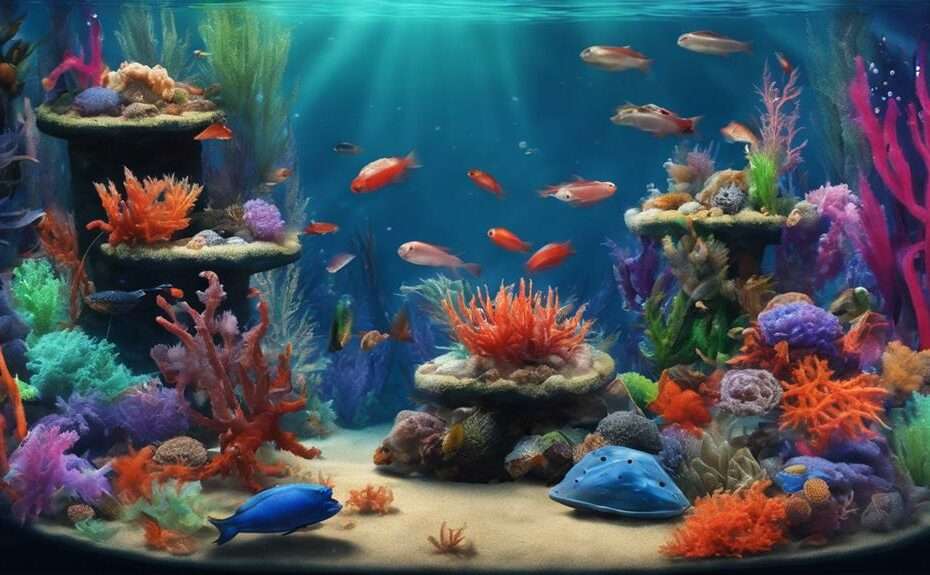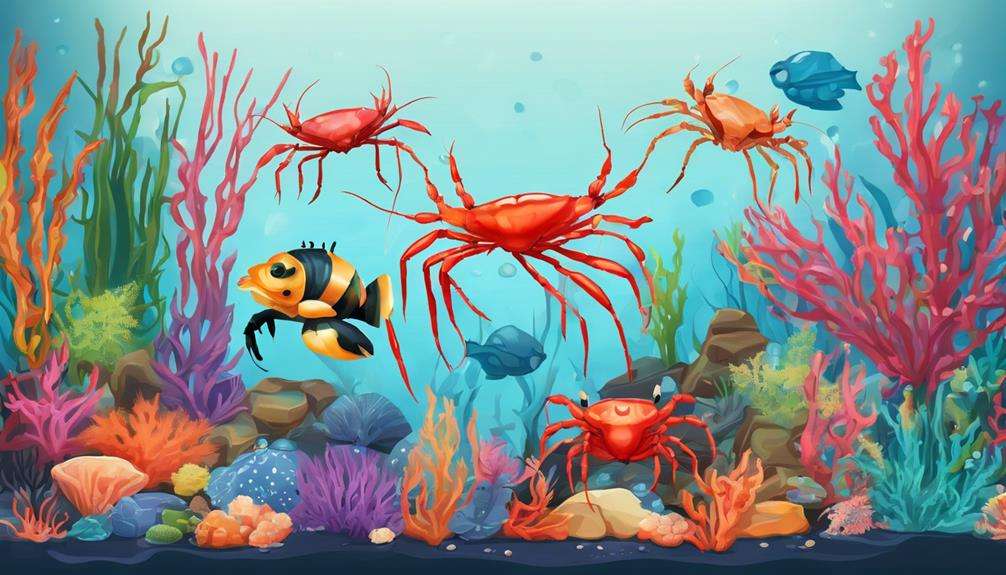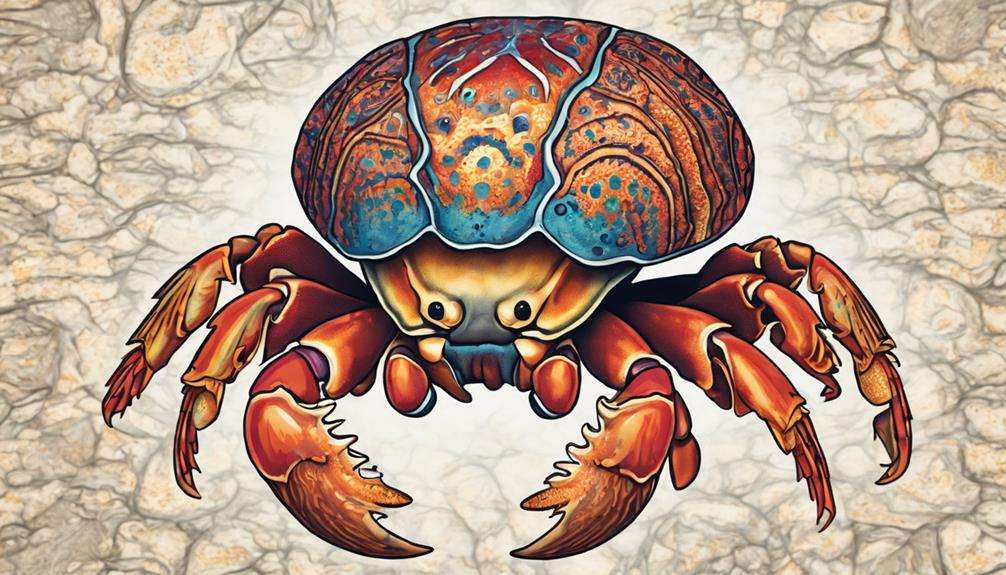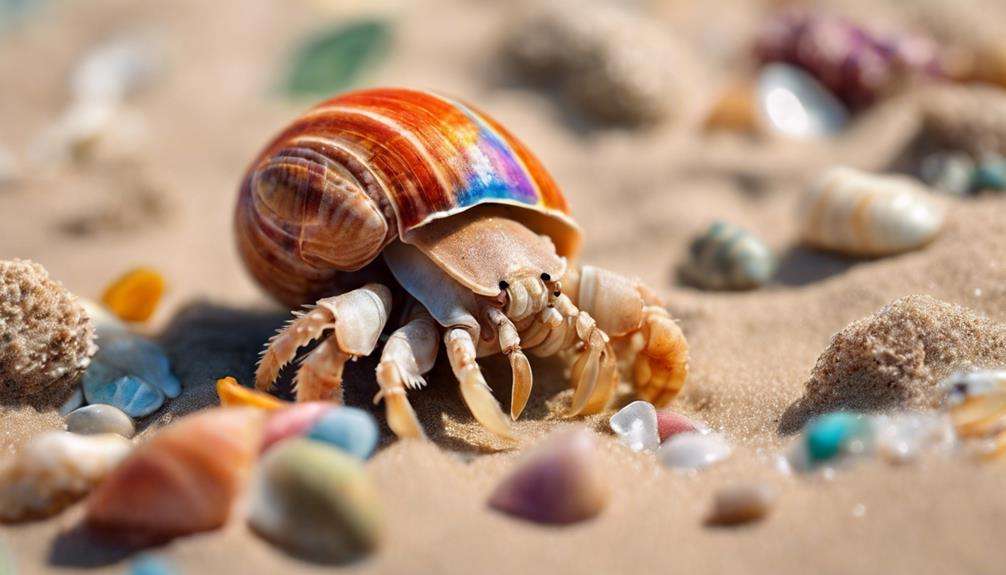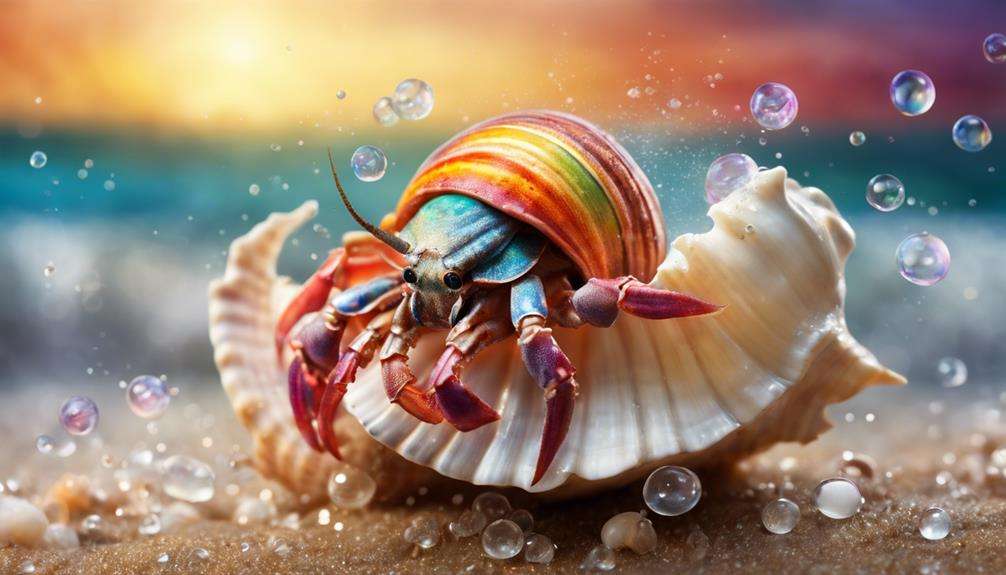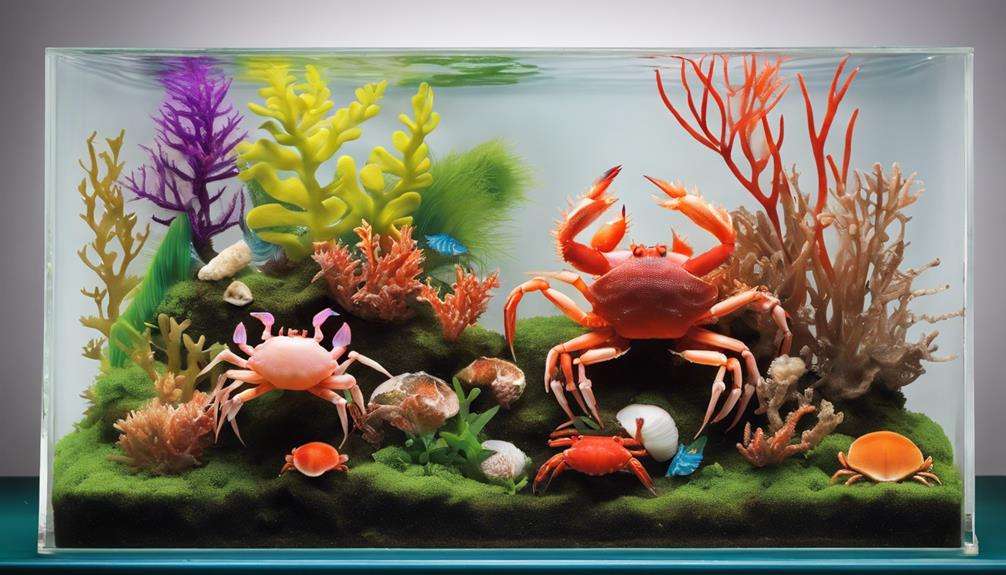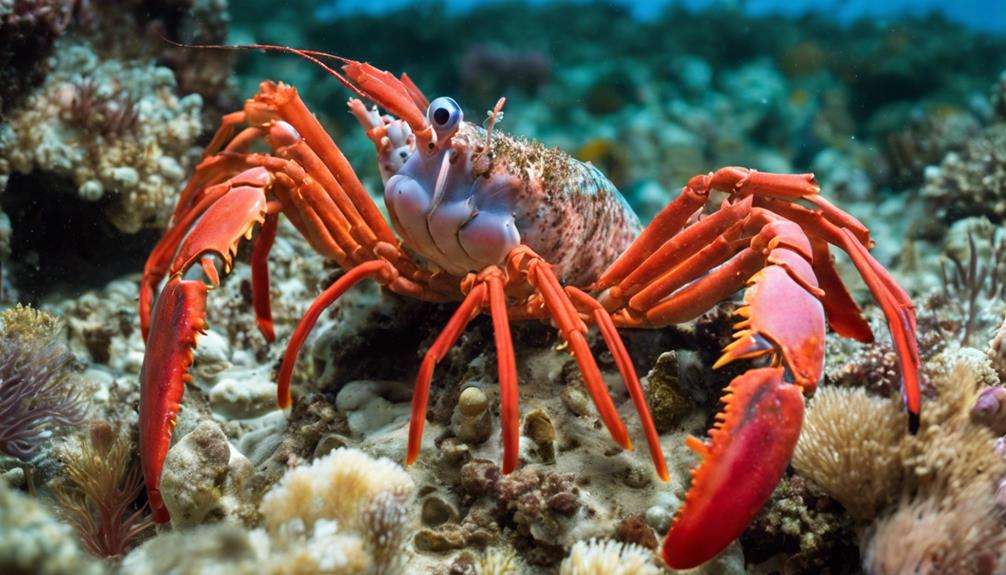Have you ever wondered what it takes to care for distinctive crustaceans like hermit crabs and vampire crabs? These fascinating creatures require specialized attention to thrive in captivity, and understanding the seven best practices for their care is essential.
From setting up a suitable habitat to monitoring their health and behavior, each practice plays a crucial role in ensuring their well-being. But what are these practices, and how can they help you create a healthy environment for your unique crustacean companions?
Key Takeaways
- Maintain stable water conditions and appropriate humidity levels for optimal health.
- Provide a diverse and nutritious diet to support vibrant colors and offspring development.
- Handle crustaceans with care, monitor their health regularly, and ensure humane treatment.
- Enrich their environment with structures, puzzles, and sensory stimuli to stimulate natural behaviors.
Proper Habitat Setup
To ensure the well-being of your vampire crabs, it's imperative to set up a suitable habitat in the form of a paludarium within a 10-gallon tank. This setup allows these distinctive crustaceans to exhibit their semi-terrestrial behavior effectively. The tank should maintain stable water conditions with a pH range of 6.5 to 8.0, providing a conducive environment for the vampire crabs to thrive. It's crucial to monitor and adjust the water parameters regularly to ensure the health and vitality of your crustaceans.
In addition to water quality, maintaining appropriate humidity levels between 70% and 80% is essential. This can be achieved through misting the habitat regularly and utilizing high-quality substrate that retains moisture effectively. Vampire crabs require this higher humidity to support their respiratory functions and overall well-being.
Furthermore, regulating the temperature within the range of 75-82°F is crucial for creating an optimal environment for your vampire crabs. By paying close attention to these factors and providing a well-balanced habitat, you can ensure the comfort and health of your unique crustacean pets.
Adequate Lighting and Temperature
Ensuring proper lighting and maintaining the recommended temperature range of 72°F to 82°F are critical aspects of creating an optimal environment for distinctive crustaceans like vampire crabs. Adequate lighting is essential for hermit crabs, including the use of low wattage night lights to establish a balanced day-night cycle. Freshwater crustaceans such as shrimp require a water temperature ideally ranging between 72°F to 82°F. Vampire crabs, on the other hand, thrive in environments with temperatures within this same range and a habitat that's well-lit.
For aquatic crustaceans, it's vital to have a reliable filtration system in place to help regulate water quality and maintain a healthy environment. Tank heaters play a crucial role in ensuring stable temperatures for freshwater species, contributing to their overall well-being. Proper lighting not only aids in maintaining a natural habitat but also supports the crustaceans' biological rhythms.
Specialized Diet Requirements
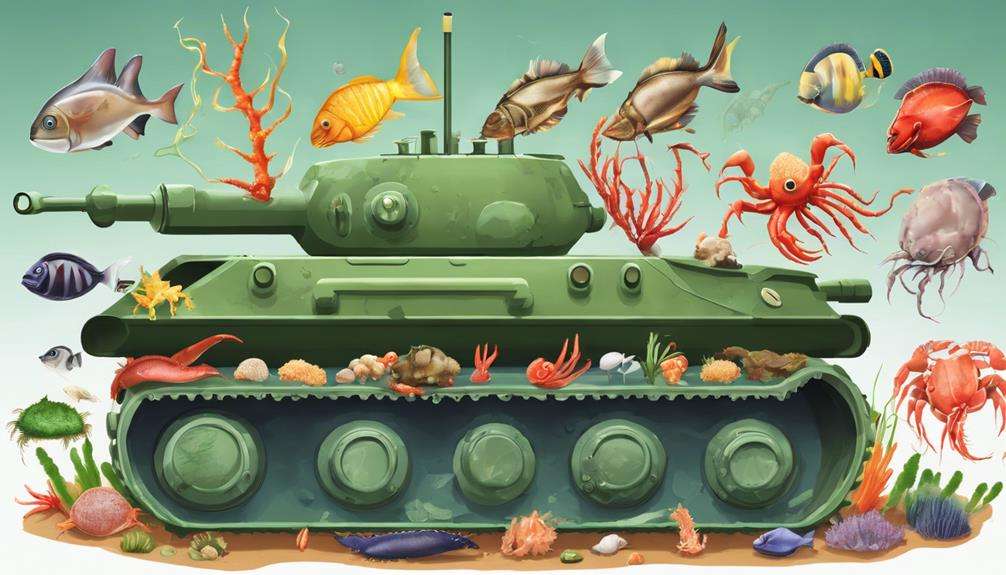
Maintaining a specialized diet is crucial for the health and growth of vampire crabs, ensuring they receive essential nutrients for vibrant colors and overall well-being. Vampire crabs, being omnivorous, require a diverse diet that includes high-quality pellets, fresh vegetables, insects, and algae wafers to meet their nutritional needs.
Their adaptability to various food sources, such as flakes and occasional protein treats, highlights the importance of providing a balanced diet. A mix of vegetables, insects, and commercial foods is essential to ensure vampire crabs receive the necessary vitamins and minerals for optimal health.
This diverse diet not only supports their well-being but also aids in the development of offspring, especially with the inclusion of protein-rich foods. Proper nutrition plays a significant role in maintaining the vibrant colors characteristic of vampire crabs, emphasizing the importance of meeting their specialized diet requirements to promote their overall health and vitality.
Handling and Interaction Guidelines
When handling crustaceans like hermit crabs and dwarf shrimp, it's essential to exercise caution to prevent stress and potential harm. These aquatic pets require careful attention to ensure their well-being and minimize stress on their delicate bodies. Here are some guidelines for handling and interacting with these fascinating creatures:
- Use Proper Tools: Utilize tongs or gloves when handling crustaceans to prevent accidental harm and avoid pinching incidents.
- Avoid Direct Contact: Refrain from bare-handed contact with dwarf shrimp to protect their sensitive bodies and prevent injury.
- Gentle Handling: When picking up hermit crabs, grasp them gently by the back of their shells to avoid distress and ensure their comfort.
- Respect Their Sensitivity: Crustaceans have intricate nervous systems, highlighting the importance of humane treatment during handling to minimize stress and potential harm.
Health Monitoring and Maintenance
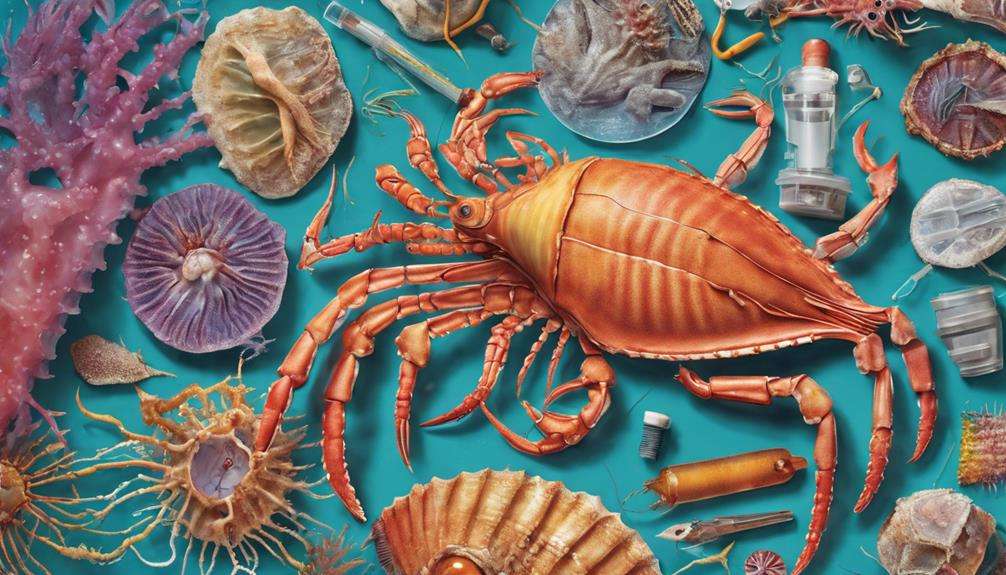
To properly care for crustaceans, vigilant health monitoring and meticulous maintenance routines are imperative. Monitoring the water parameters in the tank is crucial for the well-being of crustaceans. Regular checks of pH, temperature, and ammonia levels help maintain a healthy aquatic environment. Observing the color, appetite, and activity levels of crustaceans allows you to assess their overall health. Any abnormalities should be noted promptly to address potential issues.
Additionally, conducting routine tank maintenance, such as cleaning and equipment checks, is essential for preventing health problems.
It is important to keep a close eye on crustaceans for signs of stress, illness, or injury. Lethargy, loss of appetite, or unusual behavior may indicate underlying problems. Quarantine any sick or injured crustaceans to prevent the spread of diseases within the aquarium. Seeking veterinary care when necessary ensures proper treatment and care for the affected crustaceans.
Providing Enrichment Activities
Regularly incorporating enrichment activities into your crustaceans' habitat is essential for stimulating natural behaviors and preventing boredom. To ensure the mental well-being of your crustaceans, consider the following enrichment activities:
- Provide Climbing Structures: Introducing structures like rocks or driftwood allows crustaceans to exhibit their natural climbing behaviors, promoting physical exercise and exploration.
- Offer Food Puzzles: Implementing food puzzles or foraging activities can engage their hunting instincts, providing mental stimulation and preventing monotony.
- Include Varied Textures: Offering a range of textures such as smooth shells, rough rocks, and soft plants can cater to their sensory preferences, enriching their environment.
- Rotate Enrichment Items: Regularly changing the items in the tank prevents habituation, keeping crustaceans interested and actively exploring their surroundings.
Unique Care Considerations
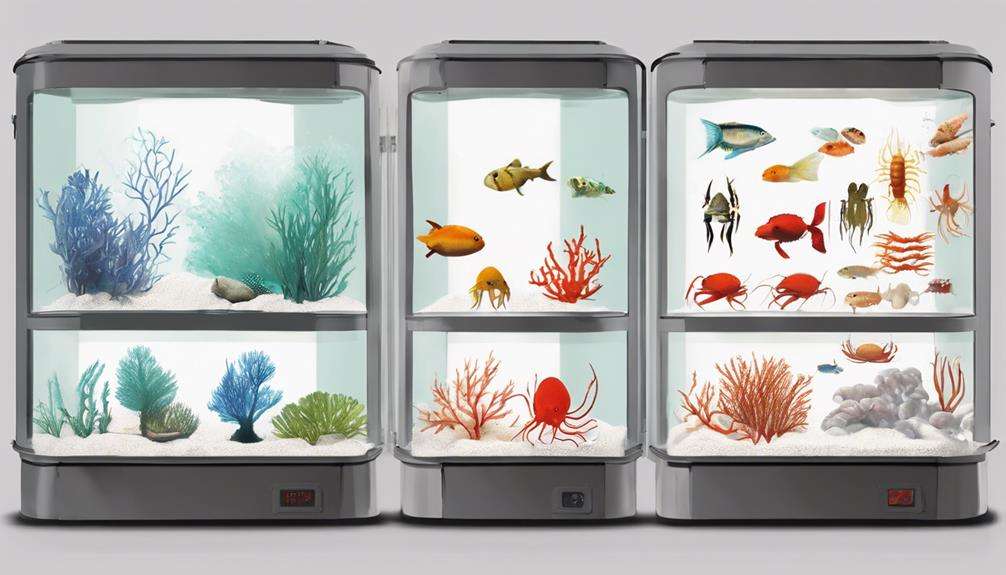
Considering the specific needs of vampire crabs, it's crucial to create a paludarium setup that accommodates both land and water areas in their habitat. Vampire crabs thrive in freshwater environments with a pH range of 6.5 to 8.0. Mimicking their natural habitat is vital for their well-being.
These crustaceans are best kept in tanks with high humidity levels between 70% and 80%, ensuring their comfort and health. To maintain a suitable environment, the minimum tank size for vampire crabs should be at least 10 gallons to provide ample space for both land and water areas.
When selecting tank mates, opt for species that are compatible with the vampire crabs' requirements and temperament. Ensuring a balanced diet is essential, with a focus on high-quality pellets, fresh vegetables, and occasional protein treats.
Additionally, maintaining temperatures between 75-82°F is crucial for the overall health and activity levels of these fascinating crustaceans.
Frequently Asked Questions
How Can We Help Crustaceans?
To help crustaceans, support conservation efforts, protect marine habitats, promote sustainable practices, combat ocean pollution, advocate for wildlife protection, ensure responsible fishing, and minimize environmental impact. Your actions can make a significant difference in their well-being.
What Do Crustaceans Need to Survive?
To survive, crustaceans need a suitable habitat, balanced diet, clean water, hiding spots, proper substrate, and specific temperature ranges. Monitoring their behavior, coloration, appetite, and activity levels is crucial for identifying signs of illness or stress early on.
What Are Three Characteristics That Are Unique to Crustaceans?
As you explore crustaceans, notice their ability for molting, the protective exoskeleton, and remarkable appendage regeneration. You'll marvel at their unique feeding habits, reproductive cycle, environmental adaptations, and even their intriguing social behavior.
Why Should Humans Care About Crustaceans?
You should care about crustaceans for their ecological importance, biodiversity preservation, and ecosystem balance. Conservation efforts, ethical considerations, and sustainable seafood practices are crucial for animal welfare, supporting healthy ecosystems and responsible consumption habits.
Conclusion
Congratulations on mastering the art of caring for distinctive crustaceans! Remember, their unique needs require careful attention and dedication. Keep up with proper habitat setup, lighting, temperature, diet, and enrichment activities for their well-being. And don't forget to monitor their health and behavior closely.
With your commitment to providing the best care possible, your crustaceans are sure to thrive – unless, of course, they decide to stage a crustacean rebellion!
